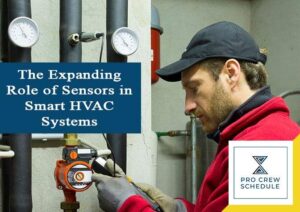Sensors may be small, at times almost invisible, but sensors are vital components in any Smart HVAC system. Sensors will be even more essential in the future as the Internet of Things (IoT) transforms individual systems into a network of connected devices, ensuring most of them have integrated sensors. In fact, these sensors serve as key players in helping commercial and even industrial, government and other large buildings in reaping tremendous energy savings, particularly in HVAC systems.
Only recently has there been a wide emphasis on interconnecting various sensors within HVAC systems and other systems together to build an intelligent building. The main reasons for that directly have as much to do with acknowledging the need for accomplishing energy efficiency.
For this blog, we’re going to find out the many types of sensors and their increasing contributions to HVAC systems.
Why Smart HVAC system is Smart?
Smart HVAC technology reduces energy costs, minimizes the facilities staff’s workload, and provides much better comfort conditions for the occupants or workers. But what exactly is smart HVAC and what makes it smart? Like any other type of smart building technology, smart HVAC specifically uses sensors of all kinds, to integrate with the building automation.
Other specialized HVAC equipment can fine-tune and maintain ideal temperature, airflow, and humidity in various zones. On the other hand, sensors play a huge role in keeping all the data. Here are some types of sensors in Smart HVAC.
1. Occupancy Sensors
Occupancy sensors are very useful, especially for office environments that don’t have a uniform or balance using all the time. Increasingly mobile workers are often leaving conference rooms and desks empty as much as fifty to sixty percent. Meanwhile, you’re cooling and heating space for individuals who are not even there.
These sensors can also detect anyone’s presence (commonly by detecting motion) currently using separate spaces inside the office. The data can be used to make temperature adjustments based on real-time utilization, saving more money on energy consumption.
2. Thermal sensors
Strategically-placed thermal sensors can accurately detect many differences in conditions in every zone of the building. For instance, crowded conference rooms can get warm quickly, while a widely-open workplace with higher ceilings can get chilly. Only smart HVAC systems use that data to adjust the conditions for the entire day or week.
3. CO2 sensors
A recent Harvard School of Public Health study showed that higher CO2 levels in certain buildings could significantly negatively impact the decision-making and thinking process. CO2 sensors play a huge role as they will detect the levels of CO2 gas in space. CO2 levels can increase to unwanted levels as the occupancy increases.
Once the threshold is reached, a smart HVAC system will automatically increase fresh air levels, supplying directly to space. This particular technology has a significant impact on the workforce’s well-being.
4. Light sensors
Nowadays, modern office spaces are designed to allow more natural light to come in. However, the difference in daylight from early morning until late evening and from one area of the building to another can inflict havoc on the HVAC system’s operations. As a direct result, sunny areas wind up too hot while areas with lesser natural light become too cold.
The solution? Use sensors to detect ambient light within the space and adjust both the HVAC system and the lighting accordingly.
Smart Sensor Technology in Reducing Energy Use
According to WBDG, 39% of the energy use in commercial buildings in the U.S is HVAC systems. Today, smart sensors and IoT devices are getting hyped. Smart HVAC sensors collaboratively work alongside other components tied to window treatments. It’ll help reduce energy efficiency because properly placed sensors commonly tied to any motorized window treatments can immediately adjust window shading during daytime and pick up on sunlight.
There’s no need to have the air conditioning set at a lower temperature because the rooms in the buildings will not get so warm. Motorized shades can immediately cut down on glare and heat. Hence, occupants can experience a more productive and comfortable environment.
When determining the right humidity and temperature, it is vital to keep the occupants’ productivity and comfort in the buildings. The key is to search for a zone where employees and workers are more comfortable and energy is being optimized. HVAC professionals like you can place smart wireless sensors in the following key areas:
- Spaces that aren’t in use
- At workstations
- High-density areas
- Interior walls
For HVAC professionals, one of the project managers’ duties is to make sure everything is managed correctly, from start to finish. Doing so will make the pulling of data a lot easier; projects are efficiently managed while subcontractors are well-supervised.
Sensors and Software Making Changes in Facility Management
Since buildings hold a massive amount of data that facility managers and even HVAC professionals should track and use, the forecast typically includes innovations in real-time automation, analytics and sensing. In fact, smart sensors play a significant role in the future of smart buildings. As more of your clients, the building owners often look to adopt the latest technology, you will have an easier time managing HVAC equipment and other components. Instead of adjusting HVAC systems manually, you may choose to let HVAC systems employ real-time data by smart sensors. Doing so will automatically turn up the air conditioning for workers occupying the hottest side of the building.
Smart sensors monitor building occupancy as they will start compiling essential data over time. The data will track, inform and program HVAC systems. Operators can use the collected data to make several adjustments, especially for building-wide device energy consumption, including different devices. Reviewing occupancy data is necessary for adjusting control comfort settings in labs, offices and other workplaces.
Smart building technology produces enormous data, requiring management teams and operators to consider using advanced technologies and additional labor. For HVAC professionals, online project management software is designed for their specific needs. It has a variety of real-time features intended for project management purposes.
The Digital Takeover of Sensors and Predictive Maintenance
It must come as no surprise that digital and wireless sensors are replacing the analog predecessors in the HVAC systems. The main reason behind this is that these sensors can gradually lessen wiring costs by simply communicating data wirelessly via a single variable protocol. Even there’s the continuous use of wired connectivity. They can benefit the most from the many advantages digital technology provides, such as hot-swap capability, plug-and-play installation, and automatic reconfiguration.
Take a look below:
- Digital sensors remove the need for recalibration only because the required data is stored in the sensor itself.
- Whether wireless or wired, one can directly troubleshoot the sensor networks almost smoothly from a particular remote location.
- The sensors have become far more precise in recent years. It gradually becomes more self-diagnostic.
- They provide the advantage of consistently monitoring and tracking their respective performance, reporting any anomalies through the network.
Moreover, to be truly intelligent, every system in the buildings should communicate with one another in real-time. They also need to collectively transmit data from the sensors or other components to a middle point where all data can be analyzed further and acted upon. In addition to minimizing energy consumption, the entire goal is to execute predictive maintenance and make the workplace environment more convenient for the occupants.
- Temperature sensors monitor the whole structure and sections within it.
- Humidity sensors complement every temperature sensor to determine the comfort level within the building precisely.
- The operational conditions and energy consumption in buildings with hundreds of zones can be assessed overall.
- HVAC contractors have to implement project management for construction to better handle such massive installation projects and responsibilities.
Why Do You need to Adopt Subcontractor Scheduling Software?
Getting subcontractors, materials, and equipment to the right place at the right time is always a challenge for any contractors. Unfortunately, many contractors continue to handle dispatching and scheduling with a mix of offline tools, including emails, text messages, spreadsheets, whiteboards, etc. Changing the way of managing things using a specialized software application provides real-time advantages, empowering workers to work together more efficiently over time.
Here are the reasons/advantages why you need to deploy this specialized software:
- Targets are achievable
- Incorporate flexibility into your plan
- Increasing improvement of task visibility
- Unified workflow and faster notifications
- Easy access anytime and anywhere
- Cloud-based storage for files and data
- Real-time collaboration with the team
- Structured team communication
- Construction crew management
This specialized software for scheduling provides compelling benefits compared to a mix of offline tools. Make sure you know the best and latest project management tools used today. It is the responsibility of the project manager to know all the latest trends and technology.
Currently, Pro Crew Schedule is leading the market! Experience all it offers by requesting a FREE live demo!
Key Takeaways
No question investing in smart building technology, particularly smart HVAC systems and sensors, is a critical step towards optimizing the workplace and reducing costs. We are at the start of an era where advanced sensors integrated with analytical analysis will significantly change the way commercial buildings are managed and experienced by the individuals who use and occupy them.







